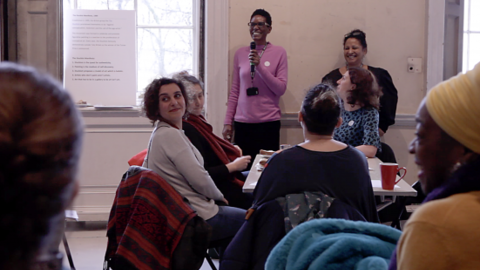Amanda Parker writes for Civil Society
29 June 2020 | By Amanda Parker
How to… embed diversity and inclusion in fundraising

This is not an easy fix. Let’s not pretend that a dynamic recruitment strategy will solve the sector’s problems with inclusion.
Despite radical, global changes in our communication methods, the actual job of fundraising hasn’t changed much since Harold Sumption’s time. The man generally acknowledged as the author of the sector’s fundamental principles, Sumption’s legacy is his articulation of the essential best practice rule of fundraising: namely that a good fundraising strategy puts the benefits of donating at the front and centre stage of any giving request.
Why focus on the wrapping, rather than the content?
Our modern take on Sumption’s principles is the emphasis on ‘story’. Great fundraising requires great compelling stories. A good fundraising story is one that shares the benefits of donating – the message about ‘what your money will do’ - in a way that is fresh, exciting, heartfelt, innovative and compelling.
What a donor buys into is the ‘story’, or the ‘content’ of a fundraising request: does the cause chime with their own values, passions or concerns? If you’re able to tell a compelling story then you’re on the way to making a great case for your charity. Equally essential is the ability to build and maintain great relationships. The donor buys the story, but the vendor – your fundraiser - makes the ‘sale’. It matters how you tell the story.
Someone like …who?
And this is where the sector goes wonky.
Because we know this – that the wrapper and the content are equally important – what too often happens next is a massive assumption, which has helped to create a fairly homogenous workforce.
The assumption is that the giver wants to hear from ‘someone like them’. This may be true, but we are misinterpreting what it means to be ‘like them’.
Organisations that fail to consider giving from the giver’s perspective repeatedly make the mistake of thinking that wealthy individuals only want to talk to others with wealth, or from comfortable backgrounds. It’s ridiculous to assume that givers can’t relate to others who don’t sit within their wealth bracket. Reducing anyone to their wealth status alone is a fatal error, and an insulting one. What about the giver’s own stories? their histories and experiences? Their intersectional, lived experience may be one of trauma, migration, challenges to health, personal loss. The ‘someone like them’ may be someone who understands who they are as people, looking beyond their cash reserves.
Avoid ‘Trauma tourism’
Where pockets of resistance to inclusion remain, I hear talk of ‘wanting to make sure donors feel comfortable’ as an explanation for the lack of diversity in the development team.
What makes the best stories? Those that ring with authenticity, because they come from an understanding of lived experience. It matters who is telling the story, but it’s about who makes the story come alive rather than who sounds like they’ve been to the ‘right’ school. Who better to tell the story than someone who knows at first hand the transformative power of successful intervention? This is not about reducing everyone to a protected characteristic. Nobody wants to be in the workplace to be wheeled out to rehash their own hard luck story in order to woo funders. That would be a crass and abusive approach to inclusion. Don’t be a ‘trauma tourist’: your inclusive team should not - and must not -feel a need to bring their own life stories into the workplace for company gain. What they should feel is that your company welcomes their wide-ranging experience, because it brings with it a wonderful beneficial warmth to the telling of your charity’s transformative stories. It will show in the eyes, in the phrasing, in the story telling - and your donors will love it (and them).
Embed – and make room
How to embed inclusion in your team? First of all, accept, and make a viable transition strategy for some in the organisation to move on. Yes. To be inclusive, space must be made! This may be by re-thinking what your team requires – and your team may require someone who has lived experience of your charitable cause, or lived experience of a transformative intervention. The team may need to reflect the demographic of the people it helps, to enable your charity to get stronger stories, and create more effective interventions. Diversifying your team could help you to tell a more authentic story. The relationship between donor and fundraising teams should feel like a partnership, not a meeting from opposite sides of a fence. What you want is a partnership with someone who gets what you want to achieve and supports it. Your diverse fundraiser is best placed to bring your donor into an area they are literally paying to access: the space where they can see how their money is making a difference. There can be no better guide than someone who speaks the language of both perspectives.
Advertise imaginatively, and where your target demographic is found. If you advertise in charity sector publications alone, I’m guessing you will get people who… mostly work in the charity sector! And we already know that the sector is not as diverse as it would like to be, so break the cycle and advertise where your target demographic will actually see the ads.
Reassess the job requirements in terms of competencies not qualifications. Can you create a job description that asks for examples where people can demonstrate the skills the role needs? Do you have capacity to train and develop someone with potential – irrespective of their education, status or age? Does your ‘new recruit’ have to be new to the workplace (young)? Or just new to fundraising?
Actively recruit for transferable skills and personal qualities, not qualification.
Include – by changing the company culture
But how to make sure those with intersectional lived experience thrive in your organisation? Through providing ongoing training – not for the incomer, but for the whole company. If your organisation doesn’t have diverse fundraising capacity, perhaps you need to examine company culture, or values. Does your workplace assume everyone learned to play piano as a child, or go on skiing holidays? Does the workplace banter presume that everyone grow up with two parents of different genders, and that everyone had pocket money as a child? Do you always have team celebrations in the pub? After hours? There are so many ways to improve the working environment – and much of it is centred around not making assumptions, and remaining curious. There are online guides about using inclusive language in the workplace: use them. Make diversity an integrated aspect of your workplace: every budget line should have an allocation that allows the budget holder to ask, test and address the question, ‘how can I make this activity more inclusive’? Vary the time, place and style of workplace communications, celebrations and meetings. If your team meeting is always on a Wednesday morning, that may mean that your part-time worker always misses it. If you always celebrate birthdays in the pub, your Muslim staff may never join in.
And give everyone the chance to lead – however small. Rotate who you hear from, and who leads on and reports on projects.
Retain – by giving feedback channels
The best way to include is to facilitate self-empowerment. Don’t ‘empower’: many people just want you to give them the space to do it themselves, thank you very much. Can you create anonymous – genuinely anonymous – feedback channels where staff can make suggestions that then are acted upon?
If your workplace is too small to allow anonymity, you can create a culture of open feedback and continuous improvement.
And feed back to your givers.
If you can stop expecting intersectional staff to change their style and approach to show their ‘cultural fit’ with the existing (dominant) culture, then you will have a powerful message to play back to givers: this is a place where everyone can be themselves’. That’s a message few can resist.
Read the original article in Civil Society here.


